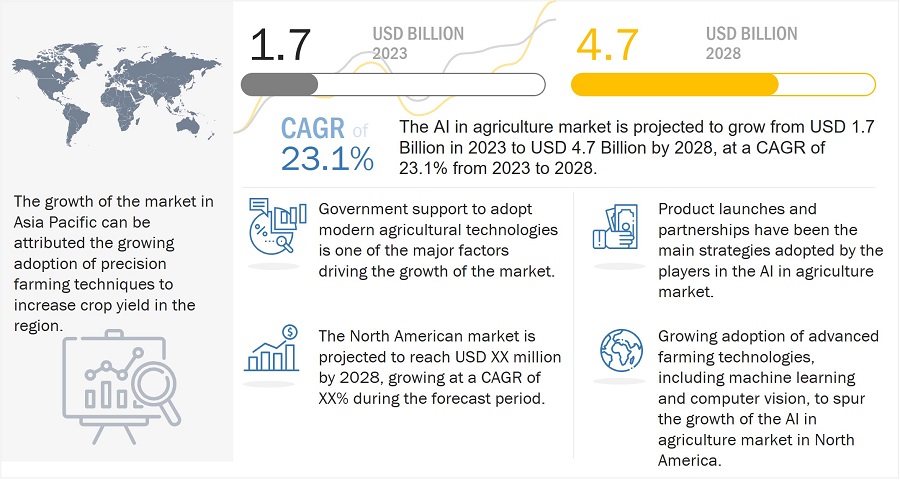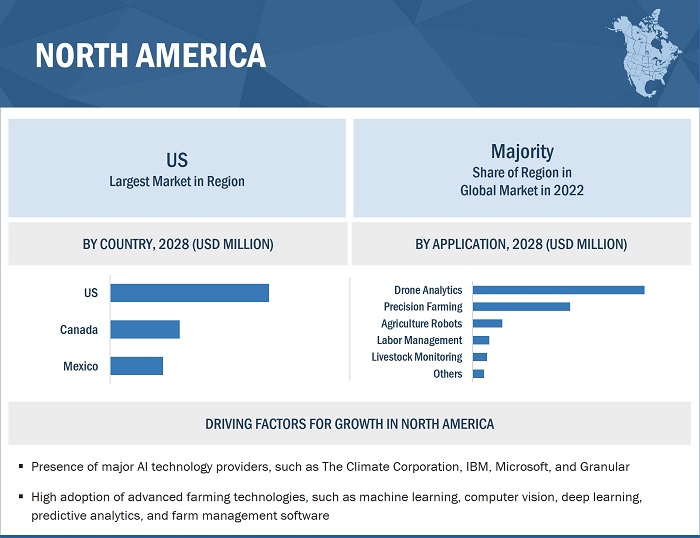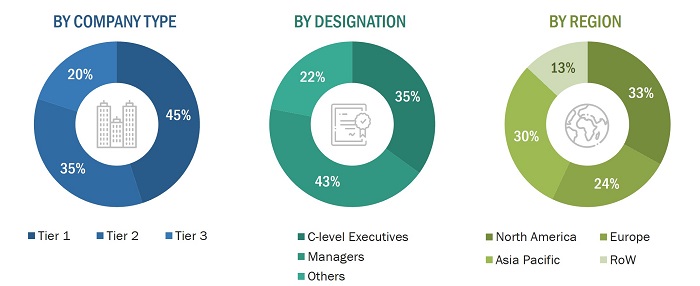Artificial Intelligence in Agriculture Market Size, Share & Industry Growth Analysis Report by Technology (Machine Learning, Computer Vision, and Predictive Analytics), Offering (Software, AI-as-a-Service), Application (Drone Analytics, Precision Farming) and Region - Global Forecast to 2028
Updated on : October 22, 2024
Artificial Intelligence in Agriculture Market Size & Growth
The Artificial Intelligence in Agriculture Market size is projected to grow from USD 1.7 billion in 2023 to USD 4.7 billion by 2028; growing at a Compound Annual Growth Rate (CAGR) of 23.1% from 2023 to 2028.
AI in agriculture offers several advantages to the farmers such as real-time insights from their fields, monitor soil quality, plant health, temperature, automate irrigation, pesticide process- all of which are helping to improve the overall harvest quality and accuracy. AI in agriculture has various applications aimed at optimizing the efficiency of crop production such as precision farming, livestock monitoring, drone analytics, agriculture robots, labor management. Increasing crop productivity through deep learning technology driving the growth of the AI in agriculture market.
The objective of the report is to define, describe, and forecast the artificial intelligence in agriculture market share based on technology, offering, application and region.

Artificial Intelligence in Agriculture Market Forecast to 2028
To know about the assumptions considered for the study, Request for Free Sample Report
Artificial Intelligence in Agriculture Market Trends:
Rising need for real-time data by growers and farmers to take preventive measures
Increasing agricultural activities and the growing need for real-time data largely drive the market for AI in agriculture. Real-time data from agricultural farms help make prompt decisions regarding preventive measures. Farmers from North America, South America, and Europe use sensors, drones, guidance technologies, and soil sampling techniques to gather data on soil moisture and nutrient levels across their fields. Farmers and growers from the US, Canada, Brazil, and most Western European countries are turning to high-tech tools for data collection and data analysis. Drone-enabled scouting is one of the most convenient ways of collecting farm data.
Government schemes encouraging adoption of AI solutions to manage small farms
There are over 570 million farms worldwide, and 95% of all these farms are less than 5 hectares in size. AI solutions are predominantly implemented in farms with over 100 hectares of land. This can be attributed to the high initial investment required for implementing AI solutions. Farmers owning lands over 100 hectares generally have the capability to invest in AI-based solutions for farm management and other applications. However, with governments around the world supporting the use of AI for agricultural applications and providing aid to farmers with small farms, there is an opportunity for solution providers to focus on farms with less than 5 hectares of land. For instance, in the US, the Department of Agriculture provides small and mid-size producers with programs that avail farmers with easy loans and improve their technological know-how to use the best technology for farming.
High cost of AI-driven precision farming equipment
The major restraining factor for the AI in agricultural market is the high cost of AI-enabled farming products and solutions, including sensors, software, and robots. Many factors are responsible for the high cost of gathering precise field data. For instance, companies develop AI-powered solutions or platforms according to customer requirements. They offer AI-powered prebuilt and custom-built solutions such as analytics systems, virtual assistants, and chatbots. Similarly, AI features and AI management are also important factors that incur additional costs.
Availability of limited workforce with technological expertise
Artificial intelligence (AI) is a complex system, and for developing, managing, and successfully implementing AI systems, farmers require certain skill sets. For instance, people dealing with AI systems should know about technologies such as cognitive computing, machine learning, deep learning, and image recognition. In addition, the integration of AI solutions in existing systems is a difficult task that requires extensive data processing to replicate the behavior of a human brain. Even a minor error can result in system failure or adversely affect the desired result.
Artificial Intelligence in Agriculture Market Segmentation
Machine learning enabled AI in agriculture contributes largest market share through the forecast period.”
Machine learning-enabled solutions are being significantly adopted by agricultural organizations and farmers worldwide to enhance farm productivity and to gain a competitive edge in business operations. Technological advancement and proliferation in farm data generation are some of the major driving factors for the AI in agriculture market. With the use of machine learning farmers able to capture the factor of soil, seeds quality fertilizer application, environmental variables and irrigation.
AI in agriculture market for software segment is to hold the largest market share through the forecast period.
artificial intelligence in agriculture market share has been segmented based on offerings into hardware, software, AI-as-a-service, and service. Software segment is to hold the largest market share through the forecast period. The software integrated into a computer system is responsible for carrying out complex operations. It synthesizes the data received from the hardware and processes it in the AI system to generate an intelligent response. Furthermore software segment is segmented into AI platform and AI solution. Where in AI platform data is combined with a decision-making algorithm to enable developers to create a business solution.
Precision farming application of AI in agriculture to hold significant share during the forecast period”
The market for precision farming applications was valued at USD 542 million in 2022 and is projected to reach USD 1,432 million by 2028; it is expected to grow at a CAGR of 20.5% during the forecast period. This segment is likely to continue to hold the second-largest market share in the coming years due to the high adoption rate of AI technologies for precision farming applications. Precision farming and automatization in food production are priorities for food growers in the current situation, and AI fuels the gains.
Market for computer vision technology based AI products is expected to grow at highest CAGR during forecasted period.
The AI in agriculture market has been segmented based on technology into machine learning, computer vision, and predictive analytics. Artificial intelligence in agriculture market for computer vision technology based AI products is expected to grow at highest CAGR during forecasted period. This high growth rate is attributed to the rising need for continuous monitoring and analysis of crop health and increasing use of computer vision technology in agricultural applications such as sorting the produce according to weight, color, size, and ripeness and identifying defects in agricultural produce.
Artificial Intelligence in Agriculture Industry Regional Analysis
North America is to contribute the largest in the market during the forecast period
The North America held the largest artificial intelligence in agriculture market share during the forecast period. The AI in agriculture industry in this region has been segmented into US, Canada and Mexico. North America has large scale agriculture players in the region are already using AI technology to significantly improve the speed and accuracy of their planting and crop management techniques. The demand for advanced agricultural solutions is expected to drive the growth of the AI in agriculture market in this region.

Artificial Intelligence in Agriculture Market by Region
To know about the assumptions considered for the study, download the pdf brochure
In the process of determining and verifying the market size for several segments and subsegments gathered through secondary research, extensive primary interviews have been conducted with key industry experts in the AI in agriculture market space. The break-up of primary participants for the report has been shown below:
- By Company Type: Tier 1 – 45%, Tier 2 – 35%, and Tier 3 – 20%
- By Designation: C-level Executives – 35%, Directors – 43%, and Others – 22%
- By Region: North America –33%, Asia Pacific– 30%, Europe – 24%, and RoW – 13%
Top Artificial Intelligence in Agriculture Companies - Key Market Players
- Deere & Company (US),
- IBM (US),
- Microsoft (US),
- The Climate Corporation (US),
- Farmers Edge Inc. (Canada),
- Granular Inc. (Canada),
- AgEagle Aerial Syatems Inc. (US),
- Descartes Labs, Inc. (US).
Artificial Intelligence in Agriculture Market Report Scope
|
Report Metric |
Details |
|
Estimated Market Size |
USD 1.7 billion in 2023 |
|
Expected Market Size |
USD 4.7 billion by 2028 |
|
Growth Rate |
CAGR of 23.1% |
|
Market size available for years |
2019—2028 |
|
Base year |
2022 |
|
Forecast period |
2023—2028 |
|
Units |
Value (USD Billion) |
|
Segments covered |
Technology, offering, application, and geography. |
|
Geographic regions covered |
North America, Europe, Asia Pacific, and RoW |
|
Companies covered |
Deere & Company (US), IBM (US), Microsoft (US), The Climate Corporation (US), Farmers Edge Inc. (Canada), Granular Inc. (Canada), AgEagle Aerial Systems Inc. (US), Descartes Labs, Inc. (US) are the major players in the market. |
Artificial Intelligence in Agriculture Market Highlights
This report categorizes the AI in agriculture market share based on technology, offering, application, geography.
|
Segment |
Subsegment |
|
AI in Agriculture Market, by Technology: |
|
|
AI in Agriculture, by Offering: |
|
|
AI in Agriculture Market, by Application: |
|
|
AI in Agriculture Market, by Region: |
|
Recent Developments in Artificial Intelligence in Agriculture Industry
- In May 2022, Alliance for a Green Revolution in Africa (AGRA) and Microsoft announced the expansion of their partnership to advance digital agriculture transformation in Africa to improve food security. The partnership of AGRA with Microsoft will support governments, farmers, and small and medium-sized enterprises (SMEs) to build food systems in the region by using digital tools provided by Microsoft.
- In February 2022, Farmers Edge and Deere & Company (US), a manufacturer of agriculture machinery and heavy equipment, entered into an agreement allowing users of FarmCommand to integrate their data with the John Deer Operations Center account. This will give users the insights to make decisions that drive yields and profits.
- In October 2021, IBM launched the IBM Environment Intelligence Suite, an AI-driven software for environment intelligence that helps companies anticipate the climate risks, such as floods and wildfires, and understand agricultural production and market intelligence by providing weather data, climate risk analytics, and carbon accounting.
- In March 2021, Climate LLC, a Bayer Crop Science Digital arm subsidiary, launched the industry-leading digital farming platform, climate FieldView, in South Africa. Launching the product in the African region helps the farmers manage risk and increase productivity while simplifying their operations actively.
- In January 2020, Descartes Labs launched a cloud-based geospatial data refinery and modeling platform called the Descartes Labs Platform. This platform has improved forecasting abilities in agriculture.
Frequently Asked Questions (FAQ):
Which are the major companies in the AI on agriculture market? What are their major strategies to strengthen their market presence?
Deere & Company (US), IBM (US), Microsoft (US), The Climate Corporation (US), Farmers Edge Inc. (Canada), Granular Inc. (Canada), AgEagle Aerial Syatems Inc. (US), Descartes Labs, Inc. (US). These companies have adopted organic as well as inorganic growth strategies such as product launch, innovation in product, and partnerships to gain competitive advantage in the market.
Which is the potential market for AI in agriculture in terms of the region?
Asia Pacific is the region with high growth opportunities owing to the presence of countries such as China, Japan, South Korea, India and Australia. Rising adoption innovative technologies in industries in China, South Korea, Japan and India also facilitate growth to the market.
What are the opportunities for new artificial intelligence in agriculture market entrants?
Development of AI solutions to manage small farms, use of drones to improve farming are creating opportunities for the players in the market.
Which applications are expected to drive the growth of the artificial intelligence in agriculture market in the next six years?
Drone analytics is expected to remain the major application driving significant demand for AI in agriculture market. Ability of drones to capture high-resolution aerial images in a single flight irrespective of farm areas, thereby enabling cost-effective and highly accurate data collection even in overcast conditions has driven the adoption of drones in the agricultural applications.
To speak to our analyst for a discussion on the above findings, click Speak to Analyst

The study involved four major activities in estimating the size for AI in agriculture market. Exhaustive secondary research was done to collect information on the market, peer market, and parent market. The next step was to validate these findings, assumptions, and sizing with industry experts across value chains through primary research. The bottom-up approach was employed to estimate the overall market size. After that, market breakdown and data triangulation were used to estimate the market size of segments and subsegments.
Secondary Research
In the secondary research process, various sources were referred to for identifying and collecting information important for this study. Secondary sources include corporate filings (such as annual reports, investor presentations, and financial statements); trade, business, and professional associations; white papers, AI in agriculture-related journals, and certified publications; articles by recognized authors; gold and silver standard websites; and directories.
Secondary research was mainly conducted to obtain key information about the market value chain, the industry supply chain, the total pool of key players, market classification and segmentation according to industry trends to the bottom-most level, and key developments from both market- and technology-oriented perspectives. Data from secondary research was collected and analyzed to arrive at the overall market size, which was further validated by primary research.
Primary Research
Extensive primary research has been conducted after understanding and analyzing the AI in agriculture market through secondary research. Several primary telephonic interviews have been conducted with key opinion leaders from the demand- and supply-side vendors across four major regions—North America, Europe, Asia Pacific, and the Rest of the World (RoW). Moreover, questionnaires and emails were also used to collect the data.

To know about the assumptions considered for the study, download the pdf brochure
Market Size Estimation
In this report for the complete market engineering process, both top-down and bottom-up approaches were used, along with several data triangulation methods, to estimate, forecast and validate the size of the market and its segments and subsegments listed in the report. Extensive qualitative and quantitative analyses were carried out to list the key information/insights pertaining to AI in agriculture market.
Major players in the AI in agriculture market have been identified through secondary research, and their market shares in the respective regions have been determined through primary and secondary research. The entire research methodology included the study of annual and financial reports of top players and interviews with experts (such as CEOs, VPs, directors, and marketing executives) for key insights (quantitative and qualitative). All percentage shares, splits, and breakdowns have been determined using secondary sources and verified through primary sources. This data was consolidated and enhanced with detailed inputs and analysis from MarketsandMarkets and presented in this report.
AI in Agriculture Market: Bottom-Up Approach

AI in Agriculture Market: Top-Down Approach

Data Triangulation
After arriving at the overall size of the AI in agriculture market from the estimation process explained above, the total market was split into several segments and subsegments. The market breakdown and data triangulation procedures were employed, wherever applicable, to complete the overall market engineering process and arrive at the exact statistics for all segments and subsegments. The data was triangulated by studying various factors and trends from both the demand and supply sides. Along with this, the market size was validated using both the top-down and bottom-up approaches.
Report Objectives
- To define, analyze, and forecast the artificial intelligence (AI) in agriculture market, in terms of value, by technology, offering, application, and region
- To forecast the market size for various segments with respect to four main regions: North America, Europe, Asia Pacific, and Rest of the World (RoW)
- To provide detailed information regarding drivers, restraints, opportunities, and challenges influencing market growth
- To strategically analyze the micromarkets1 with respect to individual growth trends, prospects, and contributions to the total market
- To provide a detailed overview of the value chain in the artificial intelligence in agriculture market and analyze the market trends
- To analyze opportunities in the market for various stakeholders by identifying the high-growth segments of artificial intelligence in agriculture market
- To strategically profile the key players and comprehensively analyze their market position in terms of ranking and core competencies2, along with detailing the competitive landscape for the market leaders
- To benchmark players within the market using competitive leadership mapping, which analyzes market players on various parameters within the broad categories of business and product strategies
- To map the competitive intelligence based on company profiles, key player strategies, and game-changing developments, such as product launches, partnerships, and acquisitions
- To analyze the probable impact of the recession on the market in the near future
Available Customizations
With the given market data, MarketsandMarkets offers customizations according to the specific requirements of companies. The following customization options are available for the report:
Product Analysis
- Detailed analysis and profiling of additional market players



 Generating Response ...
Generating Response ...










Growth opportunities and latent adjacency in Artificial Intelligence in Agriculture Market